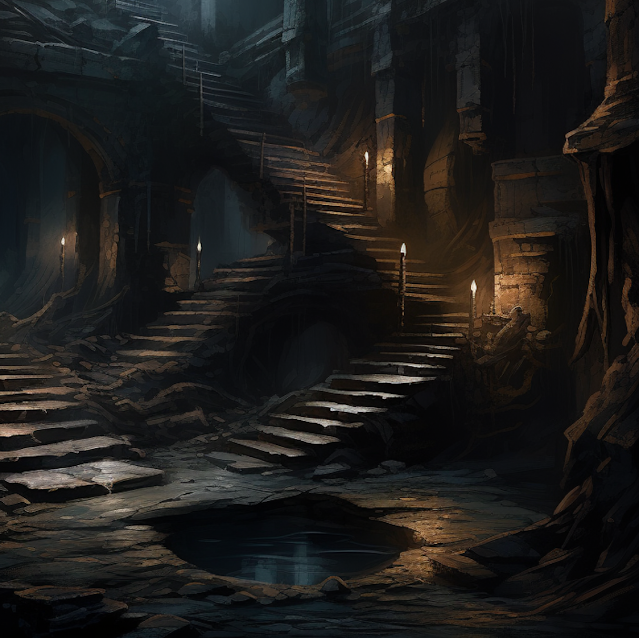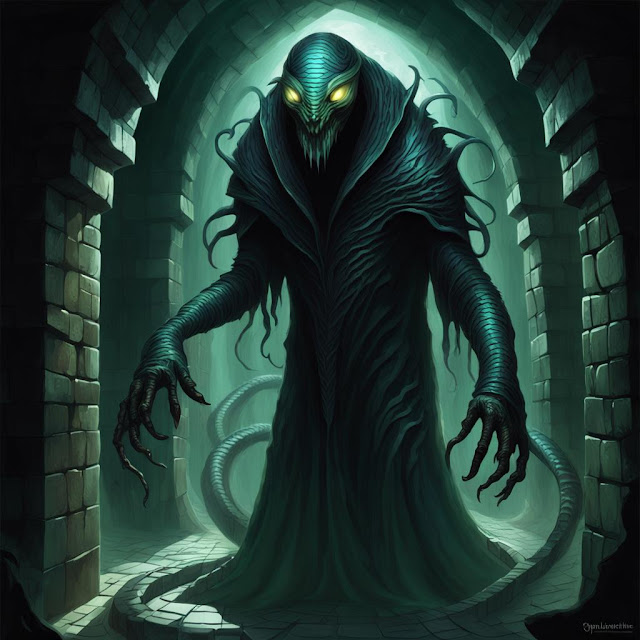One of the last major gods of this Pantheon is Schmied, the god of craftsmen, ironworking, fire, and dwarves. He is often depicted as a dwarf.
Schmied
Schmied is a syncretic god who combines aspects of the Greek Hephaestus, the Roman Vulcan, the Norse Sons of Ivaldi and the myth of Weyland the Smith and thus Goibhnie of the Celts. All of these figures are related and likely all trace their origin back to a Proto-Indo European Smith God. Given the book I am reading now on PIE language reconstruction this could have been the God credited with giving humanity the wheel.
Schied here has a bit of all these gods as seen through the idea of the grumpy dwarf. I opted to take this somewhat stereotypical route because I figure he is the source of this archetype. I wanted him dour, grumpy, and largely unlikable. This comes, I admit, more from my readings of Goidhnie (Gowan) of the Celts. Though Vulcan and the Sons of Ivaldi were not going to win any popularity contests. Which interestingly enough, gets me to the first myth of the god.
Both Hephaestus and Vulcan are married off to their myths respective Goddess of Love. Here is where I wanted to differ. I honestly can't see Liebhaberin getting married at all. She is too busy cultivating young (and thus pre-married) love. But I did want to have a myth where Schmied got married to a beautiful woman, largely by trickery. Like I said he is an unpleasant god.
Schmied and Skalda
Skalda (note: not exactly Skaldi) was the beautiful goddess of Song and Poetry, in particular epic poetry. She decided one day she needed a husband. So she sought out the Gods to find a suitable candidate. Skalda wanted to find a husband among the greatest of Gods so she announced her attention. Her eye was set on Jäger and she began to openly court the God. His sister Jägerin, would not have it seeing Skalda as trying to improve her own standing among the gods. So she convinced Schmied, who she knew desperately desired Skalda, to begin to send her gifts. Schmied fashioned a lute of pure gold that would play itself if commanded to Skalda. He sent her a breastplate of gold. A spear fashioned out of the rays of the sun. And automaton handmaidens carved out of pure ivory and inlaid with gold that were indistinguishable from living nymphs.
Skalda, who believed that it was Jäger who sent her all these gifts swore before the Gods that she would only marry the God who had sent her such wonderful treasures. Expecting Jäger to step forward she was shocked and disgusted to see it was not the Bright God of the Sun, but the twisted God of Smiths. But an oath before the Gods is an oath unbreakable.
They did produce a son, Künstler, the God of fine art. But she has refused his bed ever since.
SCHMIED (God of Smithing, Crafting, Fire and Dwarves)
Intermediate God
ARMOR CLASS: 2
MOVE: 9"
HIT POINTS: 275
NO. OF ATTACKS: 2
DAMAGE/ATTACK: 1d10+5, 1d10+5
SPECIAL ATTACKS: Summon fire
SPECIAL DEFENSES: +1 or better to hit
MAGIC RESISTANCE: 70%
SIZE: M (4' 1")
ALIGNMENT: Neutral
WORSHIPER'S ALIGN: All, smiths, craftsmen, dwarves
SYMBOL: A large hammer
PLANE: Erde (Prime Material)
CLERIC/DRUID: 10th level Cleric
FIGHTER: 5th level Fighter
MAGIC-USER/ILLUSIONIST: 10th level Magic-user
THIEF/ASSASSIN: Nil
MONK/BARD: Nil
WITCH/WARLOCK: Nil
PSIONIC ABILITY: II
S: 23 I: 12 W: 20 D: 16 C: 24 CH: 8
Schmied is the god of craftsmen, smiths, fire (in its creation aspect), as well as dwarves and kobolds. He appears as a heavily muscled dwarf covered in soot and grime from working in the forge.
Schmied has very little to say to others. He prefers to spend his time in the forge working with his brothers (who have demigod status) creating items of great art. It is said that his forge can create anything and the magic items the gods wield were all created here.
In combat, he swings a giant hammer for 1d10+5 points of damage twice per round. He has the spell-casting ability of a 10th-level magic-user and a 10th-level cleric. He is quick to anger and will use his hammer attack first and his six brothers will join in (1d8+4 for their attacks).
He is also the god of the dwarves and kobolds, or knockers.
Animal: Ox
Rainment: (Head) bare (Body) none
Color(s): Red, Black
Holy Days: The three days prior to the Summer Soltice and the three days after.
Sacrifices: An ox or bull, sacrificed and cooked in a large fire.
Place of Worship: Forges and Cave mouths.
He is married to Skalda, the beautiful goddess of epic poetry and song, but she wants nothing to do with him.
He maintains a large home for them both in Himmel, but he stays on Erde in a cave where he toils over the forges with his brothers and their kobold assistants.
Skalda
Skalda is the beautiful but haughty and arrogant goddess of epic poetry and music. While her skill unmatched, she is jealous of the other goddess and always wants more. Though when she is sitting with her lute and creating new poems, few can match her charm and eloquence.
SKALDA (Demi-Goddess of Epic Poetry and Music)
Demigoddess
ARMOR CLASS: -3
MOVE: 12"
HIT POINTS: 75
NO. OF ATTACKS: 2
DAMAGE/ATTACK: 1d8/1d8
SPECIAL ATTACKS: Charming voice
SPECIAL DEFENSES: Inspiring aura
MAGIC RESISTANCE: 25%
SIZE: M (6' 2")
ALIGNMENT: Chaotic Neutral
WORSHIPER'S ALIGN: All, Bards
SYMBOL: Lute
PLANE: Erde (Prime Material)
CLERIC/DRUID: 9th Level Cleric
FIGHTER: Nil
MAGIC-USER/ILLUSIONIST: 5th level Illusionist
THIEF/ASSASSIN: Nil
MONK/BARD: 15th level Bard
WITCH/WARLOCK: Nil
PSIONIC ABILITY: II
S: 13 I:12 W: 16 D: 18 C: 14 CH: 21
Skalda is the demigoddess of epic poetry and music. She is beautiful, eloquent, and utterly vain. She knows that her gift is required by the gods to remain in mortals' minds. The apples of Ôstara may keep the gods young and immortal, but it is Skalda's songs keep them in their hearts.
This goddess appears as a very tall (6' 2") warrior goddess. She wears a golden breastplate that only fits her, granting her very low armor class. She wields a spear that when thrown, will return to her hand and her golden lute. Once she sets the lute to play it will play independently of her.
Her voice has a constant Charm Person effect that is effective against all save for dwarves. Failing to save vs. spells means the victim is charmed and will do no harm to the goddess. She can also use her voice to inspire, granting all that hear it an additional 1d8 roll to use as needed: to attack, damage, saves or any other roll. This can be granted three times per day.
She does not have many worshipers of her own, but all Bards pay her homage.
Links
- One Man's God Special: Syncretism Part 3, the Roman-Norse Pantheon
- The Monsters
- The Gods
- Unser Vater, Father of the Gods
- Sisters of the Dawn, Liebhaberin and Ôstara
- The Mother Goddesses Herde Oberin, Mutter Natur, and Großmutter
- The Divine Twins
- Hüne Vater, Großvater, and Großmutter
- Ides, Demi-Goddess of Protection and War
- Helga, Goddess of Magic, Ghosts, and Witchcraft
- Hüter, Lord of the Dead
- Betrüger, The Trickster God
- Kriegskönig, The God of War
- Verwildert, the God of Wild Nature
- Wood Maidens
- Vater Meeren
- Schmied
- Skalda








